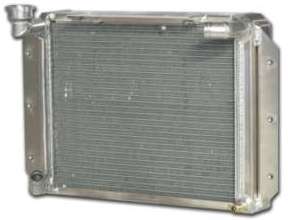The MGA With An Attitude
ALUMINUM RADIATORS, Wizard Cooling - CO-302
I must have too much time in my hands when I take the time to post this web page, since I don't even believe in using these things, except in custom applications (like a V8 engine transplant for instance). Your prerequisite to this course is CO-110 - Aluminum Radiators, The Basics.
After some consideration on price and benefits, and the fact that aluminum does not conduct heat as well as copper, you can let the suppliers of aluminum radiators try to explain to you how or why an aluminum radiator might work as well or even better than your original copper radiator. One of the small details is that the metal is thin, so heat conduction from inside to outside happens fairly quickly regardless of the metal used. Next is that heat transfer from the internal fluid to the metal, and from the metal to external air is almost independent of the type of metal used. Somewhat important is how well heat will transfer from tubes to fins, and it does that well if the internal surface area is large and the fluid flow is turbulent. Also somewhat important is how much external surface area is presented against the air flowing through the radiator. Like internal surface, more external surface area should transfer more heat to a given volume of air flow.
However, the most important of all, and perhaps the Holy Grail of radiator function, is how much air can pass through the radiator. Very small air flow means only very small heat transfer, unless the coolant can get very hot (which it does if you restrict air flow). So if density of tubes and fins is over done, then air flow may be restricted to the point of choking off cooling capacity. The "perfect" engineering of any given radiator is not going to be detailed here. The devil is in the details, but in the real world you only want to know if a particular radiator will do the job, or if it may work better than some other radiator. Manufacturer's claims aside, the only numbers that make a viable objective comparison are Thermal Capacity, commonly stated in BTU per hour (similar to heating and air conditioning in your home).

Cross flow aluminum radiator
from Wizard Cooling
|
This first example comes from Wizard Cooling. It will physically fit in the same space as the original MGA radiator, a bolt-in application (almost). It is a cross flow radiator rather than down flow, so it has side tanks rather than top and bottom tanks. It has 2 rows of 1-inch wide tubes (equivalent to a 4 row copper brass unit), TIG welded.
With no top tank to accommodate thermal expansion, you must install a coolant overflow catch bottle (coolant recovery system) to assure there will be no air trapped in the radiator core. The vendor does not seem to mention this small point. They also do not state the actual heat transfer capacity of this unit. The filler neck and hose connection pipes are in slightly different location. Original hoses should still work, but service access is slightly more restricted due to location of the pipes and hoses.
I may list other commercially available aluminum radiators for MGA here as available. I am not particularly interested in one-off hand built units that may be custom designed and likely very expensive. Anyone can spend a lot of money to have one custom built, but expensive does not necessarily equate to good thermal performance. If anyone wants to convince me that any aluminum radiator will work better than the copper cell core radiator originally specified for the MGA, they will have to do the testing and disclose the thermal performance numbers.
|
